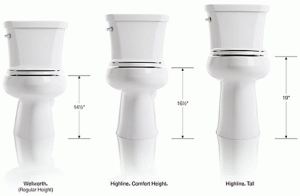What Is the Difference Between Washlet and a Bidet?
When performing a bathroom remodel in Mission Viejo, Irvine, Lake Forest, Rancho Santa Margarita, San Clemente, and other South Orange County California communities, increasingly, clients are asking about bidets. I’m finding that clients are really interested in washlets, not bidets. What is the difference between washlet and a bidet?
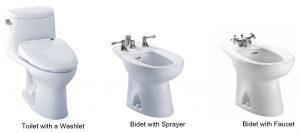
- A Washlet is a registered trademark of the Japanese toilet company Toto, used for their line of cleansing toilet seats with a warm water spray feature for external genital, anal, inner buttocks, and perineum cleansing. A washlet is a toilet seat that is affixed on top of the toilet, replacing the standard toilet seat. Therefore, a washlet allows the user to urinate, defecate (poop), and cleanse themselves on the same fixture without having to move or reposition themselves. A washlet can be used by men and woman.
- A Bidet is a type of standalone sink or fixture that resembles a toilet. It uses water with a retractable or separate hand-held sprayer, faucet, or sprays from the bottom of the bowl straight up to wash and clean the external genital, anal, inner buttocks, and perineum areas. A bidet is not a toilet. Therefore, it is not designed to accept urine, stools (poop), or tissue paper (toilet paper). After each use, it must be cleaned and sanitized. Bidets are just for women.
Tell me More About the Differences Between a Washlet and a Bidet.
Washlet
 Very affordable and practical. For example, the Toto Washlet+ C5 with remote control (has an easy to use 2 user memory to save preferred settings) includes a heated soft close seat, air deodorizer, self-cleaning wand, warm air dryer, and soft water spray for rear and front cleansing. It retails for about $819.00. The streamlined design Toto Washlet+ S550e has added features that include a sensor operated auto open/close lid with illuminating nightlight, auto flush, electrolyzed water system to automatically clean the wand and bowl after each use, and a continuous warm water stream that will last as long as you need it. This model retails for about $1,950. For the complete line of Toto washlets (with and without the toilet), please see: Toto Washlets.
Very affordable and practical. For example, the Toto Washlet+ C5 with remote control (has an easy to use 2 user memory to save preferred settings) includes a heated soft close seat, air deodorizer, self-cleaning wand, warm air dryer, and soft water spray for rear and front cleansing. It retails for about $819.00. The streamlined design Toto Washlet+ S550e has added features that include a sensor operated auto open/close lid with illuminating nightlight, auto flush, electrolyzed water system to automatically clean the wand and bowl after each use, and a continuous warm water stream that will last as long as you need it. This model retails for about $1,950. For the complete line of Toto washlets (with and without the toilet), please see: Toto Washlets. Fits almost all toilets.
Fits almost all toilets.- Washlets do not take up any additional space because they replace your existing toilet seat.
- Performs a pre-mist of the bowl before each use to prevent waste from adhering. Therefore, the toilet requires less frequent cleaning, keeping harsh chemicals out of the ecosystem.
- Environmentally friendly. There is no need for toilet paper because the entire area is washed clean. Since the average person uses 100 rolls of toilet paper each year, the savings add up fast. For a family of four, that’s 400 rolls per year! Moreover, because you don’t need toilet paper with a washlet, there is less flushing and less chance of stopping or backing up the toilet – saving even more water! With a washlet, after using, simply dry yourself using the washlets warm air dryer or use your own towel.
- Requires a GFCI recepticle for power.
Bidet
- The Toto Piedmont Elongated Deck Mount Bidet runs about $650 retail. The faucet runs about another $400-$600 for a total of about $1,000-$1,250 retail. If you don’t already have a bidet, installing the necessary plumbing will make adding a bidet very expensive; and impossible in about 90% of homes without extensive additional sewer, plumbing, and space reconfiguration work. Therefore, adding a bidet is cost prohibitive for most homeowners.
 A bidet does not take the place of a toilet. A bidet is in addition to a toilet. Therefore, to meet building code, a minimum of 60 inches of space is required for a toilet and bidet – about the size of an average master bathroom cabinet.
A bidet does not take the place of a toilet. A bidet is in addition to a toilet. Therefore, to meet building code, a minimum of 60 inches of space is required for a toilet and bidet – about the size of an average master bathroom cabinet.- Bidets are often lower than a toilet, making it difficult or painful for women who are not limber, are pregnant, or have mobility issues.
- Since you climb aboard a bidet in the opposite direction that you would sit on a toilet, you must first remove all of your clothing below the waist and your shoes. Then, properly position yourself sitting directly on top of the bidet. If you don’t sit “just right” or you decide to stand, you can easily get water all over yourself and the bathroom.
- A bidet requires more careful attention to cleaning. Because of the large surface of the rim of the bidet that you sit on (often called a sink), after-use and routine disinfection requires accuracy and frequency, or microbial contamination from one user to the next could take place.
What’s Easier to Use When Considering a Washlet or Bidet?
 Washlets are much easier and convenient to use. With a bidet, a person must first use the toilet, wipe to avoid any spillage while transferring to the bidet, remove all shoes, pants, and undergarments, mount the bidet the opposite of a toilet (you first straddle the bidet facing the wall, then sit directly on the bidet itself – there is no seat), adjust the water temperature, clean yourself, dry yourself, dismount the bidet, put your undergarments, pants, and shoes back on.
Washlets are much easier and convenient to use. With a bidet, a person must first use the toilet, wipe to avoid any spillage while transferring to the bidet, remove all shoes, pants, and undergarments, mount the bidet the opposite of a toilet (you first straddle the bidet facing the wall, then sit directly on the bidet itself – there is no seat), adjust the water temperature, clean yourself, dry yourself, dismount the bidet, put your undergarments, pants, and shoes back on.
With a washlet, simply use the toilet as you normally would. Activate the sprayer and then the warm air dryer. That’s it!
Are There Any Health Benefits Using a Washlet or Bidet?
According to gastroenterologist, washlets and bidets can prevent and alleviate hemorrhoids and yeast infections, which are common conditions in the United States. With traditional toilets, gastroenterologist Dr. John Cluley said “So, rather than smear [poop] all around, why not wash it gently with some water and then just dab it dry?
 The wiping of toilet paper often smears bacteria around rather than cleaning it up. Even when the paper appears clean, bacteria can still be present. A stream of water is much more effective for washing bacteria away. A washlet or bidet is also more likely to prevent any remaining bacteria from spreading.
The wiping of toilet paper often smears bacteria around rather than cleaning it up. Even when the paper appears clean, bacteria can still be present. A stream of water is much more effective for washing bacteria away. A washlet or bidet is also more likely to prevent any remaining bacteria from spreading.
Can’t wipe after pooping? The friction of rubbing away with dry toilet paper can lead to irritation, injury, and even anal fissures (that’s a tear in the lining of the rectum, and it’s as grim as it sounds), hemorrhoids and urinary tract infections. Washlets and bidets eliminate wiping and the spreading of bacteria. If you have hemorrhoids or prone to urinary tract infections, you should seriously consider a washlet.
Personal hygiene is greatly improved and maintained more accurately and easily with the use of a washlet or bidet compared to the use of toilet paper alone.
Does a Washlet or Bidet save Water?
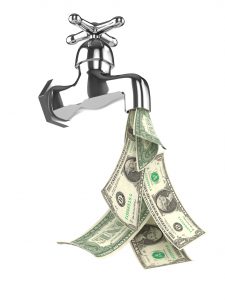 A bidet uses an average of 16 ounces of water each time you use (twice as much or more if you adjust the water temperature). A washlet uses around 12 ounces of water each time you use. With a washlet, you preset the water temperature for your preference. There is no “warm up” time and water is dispensed instantly at your preselected temperature.
A bidet uses an average of 16 ounces of water each time you use (twice as much or more if you adjust the water temperature). A washlet uses around 12 ounces of water each time you use. With a washlet, you preset the water temperature for your preference. There is no “warm up” time and water is dispensed instantly at your preselected temperature.
You avoid the need for toilet paper with a washlet. Therefore, a washlet saves you on average about $110 a year on toilet paper and an equal amount in water. Even with the additional water usage from the washlets sprayer, a washlet will save about $200 per year.
When thinking about the differences between a Washlet and a Bidet, is there anything else I should know?
Washlets are becoming increasingly popular with the ageing community and for those people with physical disabilities. These combined toilet/washlet units make independent toileting possible for many people, affording greater independence. These are often higher toilets (aka comfort height, also referred to as chair height) that allow for easier wheelchair and walker transfer. Considering the added benefits of the remote control, an individual with limited mobility or requiring assistance has much greater freedom. Upgrading to a washlet with an auto open/close lid, ease of use and freedom is increased even further. For a caregiver, a washlet allows for much easier, cleaner, and safer assistance.
A comfort height (or chair height) toilet is preferred by clients who install a washlet. A Tall toilet is preferred by those clients within the ageing community and for people with physical disabilities. Although a washlet works perfectly fine on a two-piece toilet (the tank and bowl are separate and are bolted together), clients generally prefer a one-piece toilet for the ease of cleaning that it provides (there is no space between the bowl and tank).
So, next time someone asks you “What Is the Difference Between Washlet and a Bidet?” you have all the information you need to know!
Always Hire a Reliable and Dependable Contractor to Remodel your Bathroom
 Always work with a trustworthy contractor like DAD’s Construction. We are experts in bathroom remodeling who can manage projects in an efficient manner. DAD’s Construction will do everything to minimize the possibility of change orders. Our team will make sure we have all the necessary information to prepare a proposal that meets your requirements. Rest assured that we will provide you with a detailed, by line-item contract. We will make sure that the contents of this agreement are properly and clearly communicated to you. If you have questions or need updates regarding your project, we will always answer your inquiries.
Always work with a trustworthy contractor like DAD’s Construction. We are experts in bathroom remodeling who can manage projects in an efficient manner. DAD’s Construction will do everything to minimize the possibility of change orders. Our team will make sure we have all the necessary information to prepare a proposal that meets your requirements. Rest assured that we will provide you with a detailed, by line-item contract. We will make sure that the contents of this agreement are properly and clearly communicated to you. If you have questions or need updates regarding your project, we will always answer your inquiries.
How Can I Receive More Information on Bathroom Remodeling?
If you would like more information on enjoying the best bathroom, kitchen, and interior remodeling experience in Orange County, call Dan at (949) 380-0177 or at dan@dadsconstruction.com for a free in home consultation. DAD’s serves all of South Orange County California. This includes Lake Forest, Mission Viejo, Foothill Ranch, Portola Hills, Ladera Ranch, Irvine, San Clemente, Dana Point, San Juan Capistrano, Rancho Santa Margarita, Coto de Caza, Dove Canyon, Laguna Niguel, Laguna Hills, Laguna Beach, Newport Beach, and Aliso Viejo.
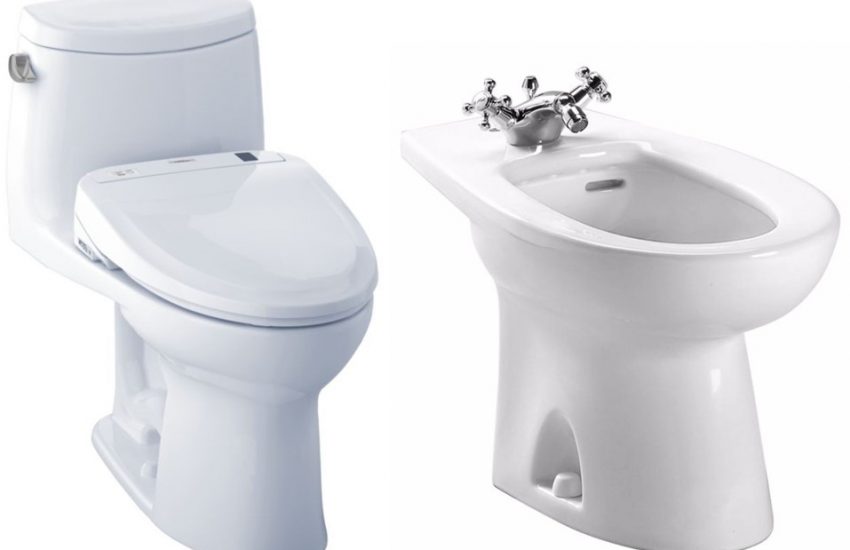
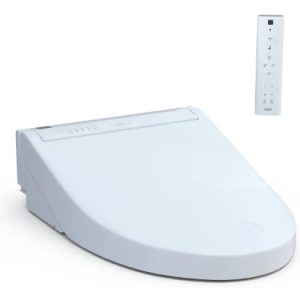
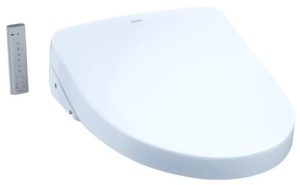 Fits almost all toilets.
Fits almost all toilets.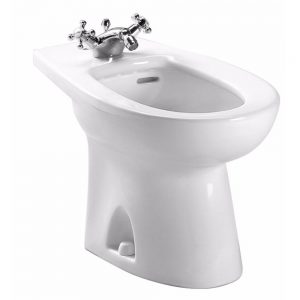 A bidet does not take the place of a toilet. A bidet is in addition to a toilet. Therefore, to meet building code, a minimum of 60 inches of space is required for a toilet and bidet – about the size of an average master bathroom cabinet.
A bidet does not take the place of a toilet. A bidet is in addition to a toilet. Therefore, to meet building code, a minimum of 60 inches of space is required for a toilet and bidet – about the size of an average master bathroom cabinet.